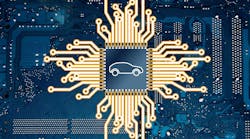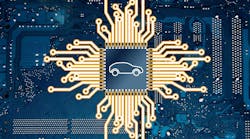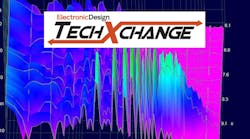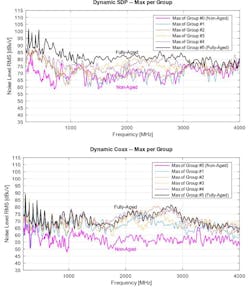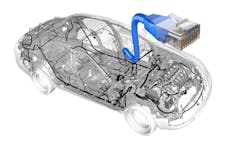EMC Testing: Can It Untangle the Future of In-Car Connectivity?
What you'll learn:
- The need for more advanced, higher-accuracy cable testing for EMI.
- Risk of signal degradation, especially in older cables.
- Today's standard cable tests fall short when it comes to real-world conditions.
On the road to higher levels of autonomous driving, automakers are integrating more and higher-resolution sensors into their vehicles. This has resulted in an unprecedented number of high-bandwidth links under the hood, many of them used to connect safety-critical advanced driver-assistance systems (ADAS). The problem, though, is that each of them is highly susceptible to the effects of electromagnetic interference (EMI).
To ensure electromagnetic compatibility (EMC) under the hood, automakers have long leaned on standard tests developed by industry groups, including CISPR, ISO, and SAE, to enhance the reliability of the cables that keep the car’s subsystems connected. These tests were developed in the era of legacy connectivity, when frequency topped out at the tens of MHz, with maximum data rates of 100 MB/s.
As connectivity requirements have shifted to speeds of up to several gigabits per second, these legacy testing methods are falling short when it comes to emulating the actual behavior of modern cars.
Streamlining In-Car Connectivity: The Importance of Cable Length
Several problems with cable testing aren’t addressed by today’s testing standards. These include cable length and the impacts of shielding degradation over time, which must be solved for future autonomous cars.
The first issue with current EMC tests is that they use relatively short 2-m cables despite modern cars being designed with architectures requiring 10- to 15-m links. In legacy interfaces that only required tens of MHz of bandwidth, any differences in attenuation between the short cables used in testing and the longer in-vehicle cables were limited to a maximum gap of approximately 4 dB. As a result, automakers could compensate for any attenuation gap with margins of a few dB added to the required immunity level.
But it’s becoming clear that channel attenuation accelerates in the higher frequencies that dominate today’s connected cars. The issue is even more pronounced when using longer cable lengths, with maximum attenuation reaching levels up to 30 dB. With so many different channels and frequencies, it’s very challenging to compensate for such a large attenuation gap.
These shorter cables have their merits, including ease of use in smaller test facilities. There are also cost savings to consider. However, this practice is no longer fit for purpose given the growing discrepancy in results. The automotive testing industry must pivot to using cables that run the length of the in-vehicle installation.
Signal Degradation: A Serious Risk to Wired Connectivity in Cars
For a long time, it was unnecessary to use aged cables in EMC testing, as the noise-penetration levels in unshielded cables changed little throughout the vehicle’s lifespan, even in dynamic installations. But even though cars can remain in use for over a decade, today’s EMC tests are conducted with new cables that don’t account for the degradation that occurs with aging.
Data travels under the hood of modern cars at significantly higher frequencies. To prevent noise, car manufacturers are using shielded cables to reduce the risk of signal attenuation. Semiconductor firms supplying them with SerDes point to the shielding as a mitigating factor against EMC. However, the shielding on the cables degrades, leaving cars susceptible to the effects of EMI after many years out on the road.
Tests comparing new and aged cables, in addition to insertion loss degradation and distortions, reveal a significant gap in noise penetration levels. Radiated immunity tests conducted by Huber Automotive both in the lab and the vehicle revealed the aging impact for both coax and SDP cables. These cables displayed a significant noise penetration gap, reaching 20 to 30 dB, between new cables and aged/stressed cables (Fig. 1). In other words, aged cables showed 10X to 30X more noise penetration than new ones.
But the use of new, shielded harnesses to test EMC performance of high-speed communication links fails to consider how much cable shielding can degrade over a vehicle’s lifespan.
This is becoming increasingly problematic as OEMs integrate more multi-gig links inside their vehicles. To better evaluate vehicle lifespan EMC performance, pre-production EMC testing of high-speed links must start using aged/stressed cables. As cables age, the signal-to-noise ratio (SNR) will continue to decrease, and this will ultimately lead to more communications failures.
It’s worth nothing that, so far, this hasn’t been a serious issue. Most camera links on the road today are relatively low bandwidth, rarely reaching over 2 GB/s, leaving a significant margin for legacy SerDes to perform without error. Higher-bandwidth links, some reaching up to 6 GB/s, are rare and haven’t been on the road a long time, leaving the shielding effective in keeping the noise out.
But as these links become more prevalent under the hood, and as they degrade with the wear and tear over the lifespan of the vehicle, the failure risk in safety-critical systems is rising.
Cable Testing: A Failure to Reflect Real-World Conditions in Cars
Due to the discrepancies in how attenuation, degradation, and noise penetration impact different cables, standard EMC testing measures have been evaluating SNRs that are very different than what cars go through out on the road.
The most widely used standards for EMC testing don’t have any requirements to use long, aged cable, which would lead to increased susceptibility of the link:
- CISPR 25, the international standard for the measurement of radio disturbances in the frequency range of 150 kHz to 5925 MHz, specifies: “The total length of the test harness between the EUT and the load simulator (or the RF boundary) shall not exceed 2000 mm (or as defined in the test plan).”
- ISO 11452-2, the international standard for component test methods for electrical disturbances from narrowband radiated electromagnetic energy, specifies: “The total length of the test harness between the DUT and the load simulator (or the RF boundary) shall be (1700 +/- 300) mm. The wiring type is defined by the actual system application and requirement.”
These tests formed in an era when automakers could emulate the in-car environment by using short cables while ignoring aging. This is no longer true for today’s high-speed, high-attenuation connected environment, and the gaps are exacerbated by the shortcomings of shielded channels that become less effective over time.
The gap between pre-production testing and what can happen in the real-world car environment over time is too large. Industry bodies must understand the significant impact this signal to noise ratio gap can have on transceivers and the quickly evolving ADAS systems that consumers are increasingly relying on to do more. The gap will continue to widen until testing methods evolve to account for target cable length, aged cables and the real-world EMI challenges that vehicles endure over their lifespan.
The Future of Automotive SerDes Depends on Accurate Cable Testing
The lack of standard testing for automotive SerDes and cables with proper cable length and aged shielding considerations is a serious issue that exposes drivers to potential hazards. Unlike other components of the vehicle, such as the engine or the brakes, which have clear regulations and performance criteria, the links that transfer data and power between different systems are under-regulated.
One of the main challenges of testing automotive cables is the complexity and wide range of conditions that they face. Cables may be exposed to extreme temperatures, vibrations, moisture, dust, chemicals, and EMI from other sources. These factors can degrade a cable's insulation, shielding, and connectors, increasing noise and signal loss. Moreover, cables may have different lengths, shapes, and bends depending on the layout of the vehicle, which can affect their impedance and resistance.
To ensure safety and reliability of ADAS links over the full lifespan of the vehicle, regulators should enforce standardized testing for automotive links, for cables and transceivers, that covers both proper cable length and aged shielding effectiveness considerations.
By implementing more stringent standardized testing, regulators can ensure that ADAS links meet the high-performance requirements of modern vehicles, preventing failures in safety-critical systems and avoiding costly recalls.
